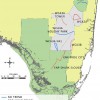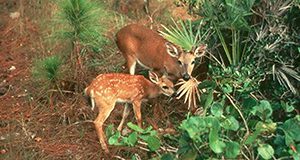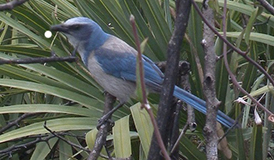Where do the animals go when the sea rises? Learn the probable futures of Florida panthers and other south Florida wildlife in this 5-page fact sheet. Written by Larry Perez, James I. Watling, David Bucklin, Mathieu Basille, Frank J. Mazzotti, Stephanie Romañach, and Laura Brandt and published by the UF Department of Wildlife Ecology and Conservation, it explains how a changing climate could impact wild animals.
edis.ifas.ufl.edu/uw428
Tag: Laura A. Brandt
The American Crocodile: An Indicator Species for Everglades Restoration

The American crocodile (Crocodylus acutus) is a top predator that lives along the southern tip of peninsular Florida, inhabiting saltwater, brackish water, or freshwater near coastal areas in mangrove-lined ponds, creeks, coves, man-made ponds, and canals. This 3-page fact sheet written by Rebecca G. Harvey, Michiko Squires, Jeff Beauchamp, Frank J. Mazzotti, and Laura A. Brandt and published by the Department of Wildlife Ecology and Conservation explains how monitoring populations of threatened crocodiles can help scientists chart the success of projects to restore the Everglades.
edis.ifas.ufl.edu/UW422
Considerations for Building Climate-Based Species Distribution Models
Climate plays an important role in the distribution of species. A given species may adjust to new conditions in-place, move to new areas with suitable climates, or go extinct. Scientists and conservation practitioners use mathematical models to predict the effects of future climate change on wildlife and plan for a biodiverse future. This 8-page fact sheet written by David N. Bucklin, Mathieu Basille, Stephanie S. Romañach, Laura A. Brandt, Frank J. Mazzotti, and James I. Watling and published by the Department of Wildlife Ecology and Conservation explains how, with a better understanding of species distribution models, we can predict how species may respond to climate change. The models alone cannot tell us how a certain species will actually respond to changes in climate, but they can inform conservation planning that aims to allow species to both adapt in place and (for those that are able to) move to newly suitable areas. Such planning will likely minimize loss of biodiversity due to climate change.
http://edis.ifas.ufl.edu/uw420
Alligator Abundance and Hydrology (2003–2013): What Long-term Monitoring Can Tell Us about Everglades Restoration
 The American alligator is a powerful indicator for Everglades restoration. It responds clearly to environmental change and is easy and inexpensive to monitor. As top predators and ecological “engineers,” alligators affect nearly all aquatic life in the ecosystem. Thus, trends in alligator populations can tell us whether restoration projects are successful. Alligators may be monitored for both short-term responses (body condition) and longer-term responses to ecosystem change (abundance). This 3-page fact sheet discusses trends in alligator abundance. It was written by Rebecca G. Harvey, Jeff Beauchamp, Robin Bijlani, Frank J. Mazzotti, and Laura A. Brandt, and published by the UF Department of Wildlife Ecology and Conservation, July 2014.
The American alligator is a powerful indicator for Everglades restoration. It responds clearly to environmental change and is easy and inexpensive to monitor. As top predators and ecological “engineers,” alligators affect nearly all aquatic life in the ecosystem. Thus, trends in alligator populations can tell us whether restoration projects are successful. Alligators may be monitored for both short-term responses (body condition) and longer-term responses to ecosystem change (abundance). This 3-page fact sheet discusses trends in alligator abundance. It was written by Rebecca G. Harvey, Jeff Beauchamp, Robin Bijlani, Frank J. Mazzotti, and Laura A. Brandt, and published by the UF Department of Wildlife Ecology and Conservation, July 2014.
http://edis.ifas.ufl.edu/uw387
Climate Change Adaptation: New Perspectives for Natural Resource Management and Conservation (WEC318/UW363)
Climate change is creating new challenges for conservation and management of natural resources. As temperatures, rainfall patterns, and disturbance regimes change and sea levels rise, ecosystems are being transformed. With climate change species and communities may move out of the fixed systems in reserves that were established to protect them, and may not have the needed migration corridors to successfully disperse. The rate at which climate is projected to change in coming decades is likely too fast for many species to genetically adapt or to migrate to new suitable areas. Climate change underscores the need to transform our view of the natural world. While many of our conservation tools and approaches will stay the same, a new perspective will enable us to better apply these tools to meet future challenges. This 3-page fact sheet summarizes recommendations from four recent reviews of the literature on climate change adaptation. Written by Rebecca G. Harvey, Laura A. Brandt, and Frank J. Mazzotti, and published by the UF Department of Wildlife Ecology and Conservation, February 2012.
http://edis.ifas.ufl.edu/uw363
The American Alligator: An Indicator Species for Everglades Restoration (WEC313/UW358)
 Scientists working on Everglades restoration cannot monitor everything in the ecosystem to determine the effectiveness of their efforts, so they use “ecological indicators” such as the American alligator. Learn how this works in this 3-page fact sheet written by Rebecca G. Harvey, Frank J. Mazzotti, and Laura A. Brandt, and published by the UF Department of Wildlife Ecology and Conservation, October 2011.
Scientists working on Everglades restoration cannot monitor everything in the ecosystem to determine the effectiveness of their efforts, so they use “ecological indicators” such as the American alligator. Learn how this works in this 3-page fact sheet written by Rebecca G. Harvey, Frank J. Mazzotti, and Laura A. Brandt, and published by the UF Department of Wildlife Ecology and Conservation, October 2011.
http://edis.ifas.ufl.edu/uw358
WEC286/UW331 Science Support for Climate Change Adaptation in South Florida
WEC286, a 5-page illustrated fact sheet by Laura M. Early, Rebecca G. Harvey, Laura A. Brandt, James I. Watling, and Frank J. Mazzotti, discusses how climate change will affect sea level and the ecosystem in South Florida and outlines the Department of Interior’s approach to manage public lands and natural resources impacted by climate change. Includes references. Published by the UF Department of Wildlife Ecology and Conservation, July 2010.
http://edis.ifas.ufl.edu/uw331
WEC282/UW327 Planning for Climate Change in South Florida: Climate Envelope Modeling for Threatened and Endangered Species
WEC282, a 3-page illustrated fact sheet by Laura A. Brandt, Stephanie S. Romañach and Frank J. Mazzotti, describes a project of the University of Florida, U.S. Fish and Wildlife Service, U.S. Geological Survey, and National Park Service to develop methods and tools that will allow natural resource managers to examine potential effects of climate change on species’ geographic ranges in the context of ecosystem and landscape planning in South Florida. Published by the UF Department of Wildlife Ecology and Conservation, May 2010.
http://edis.ifas.ufl.edu/uw327

